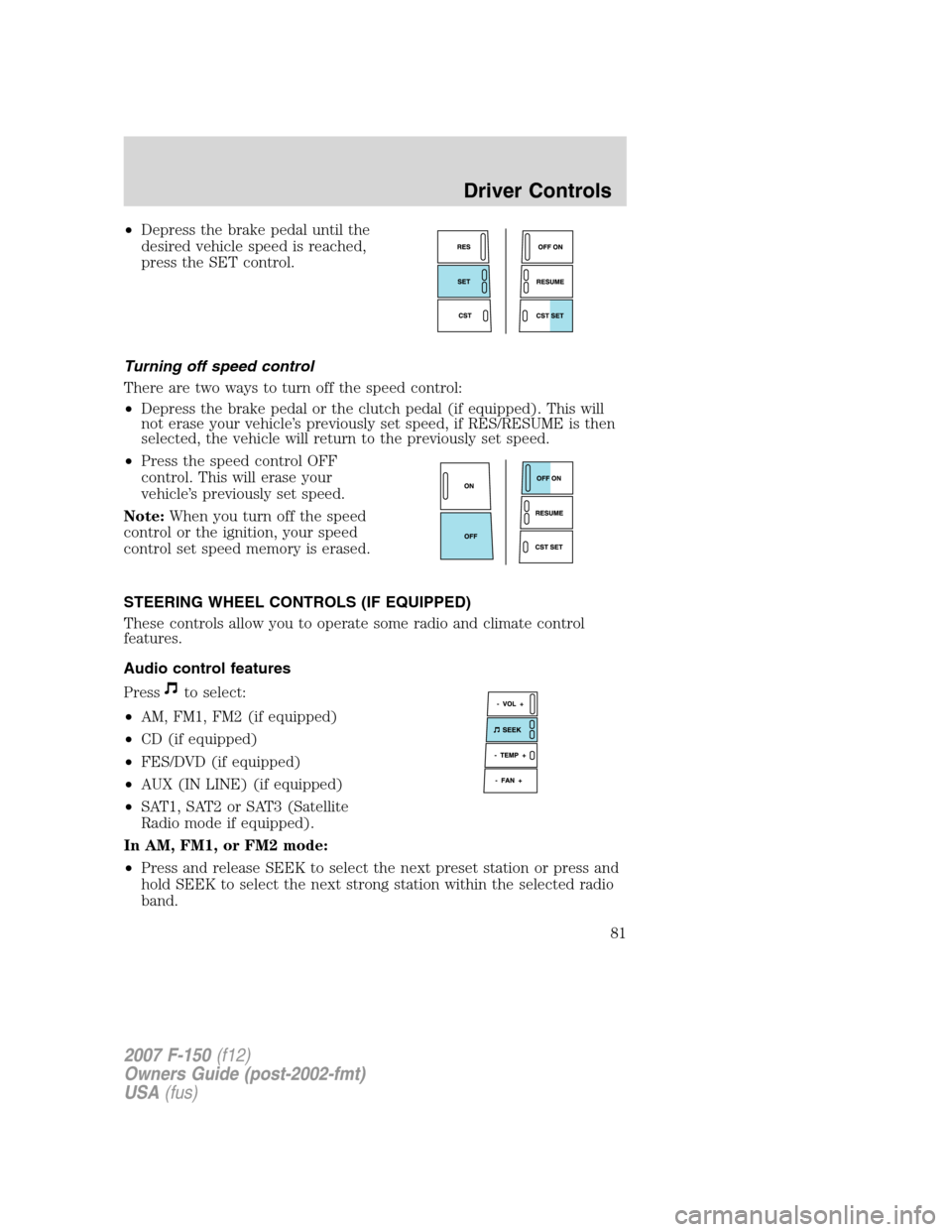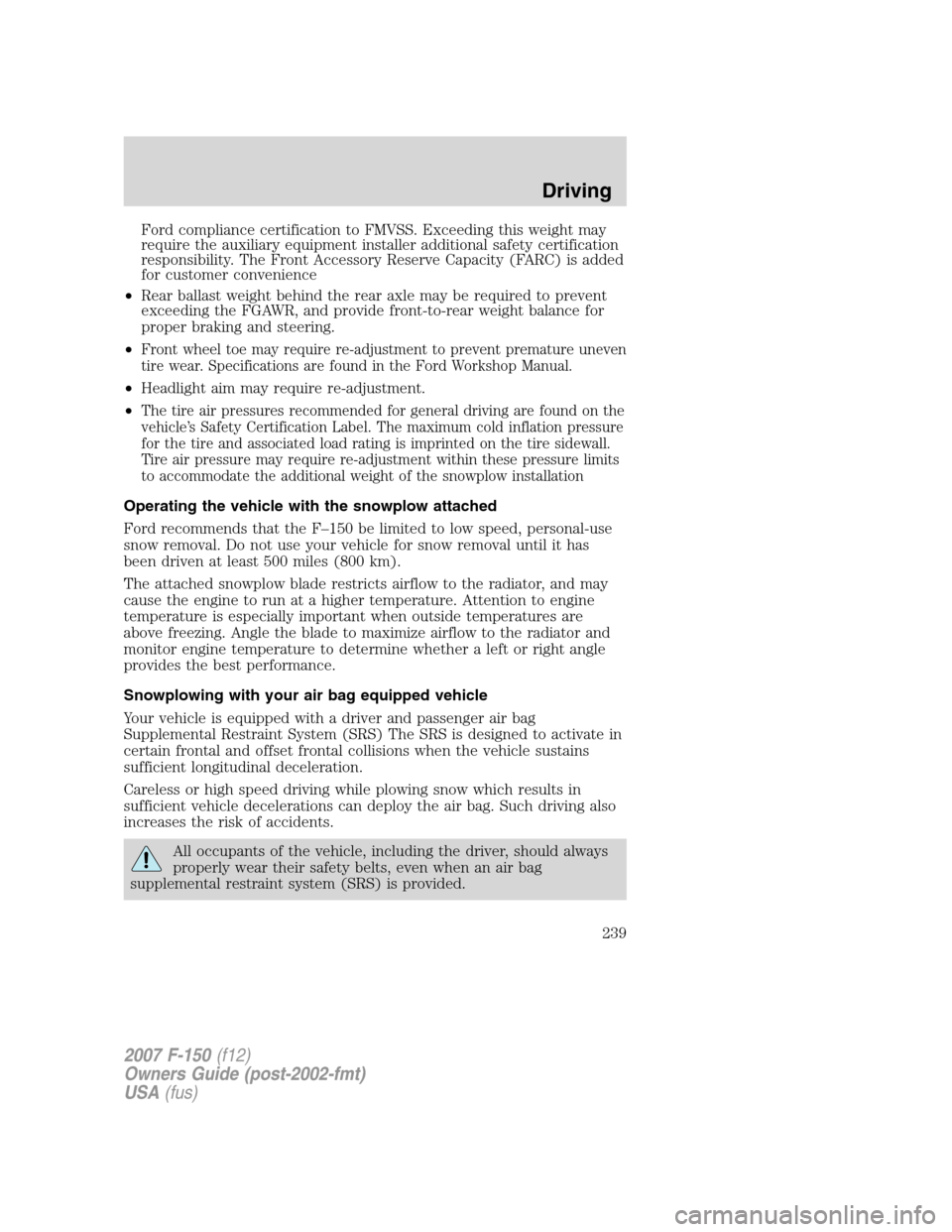Page 73 of 344

The auxiliary power point is located
on the instrument panel.
Do not use the power point for
operating the cigarette lighter
element (if equipped).
To prevent the fuse from being
blown, do not use the power
point(s) over the vehicle capacity of
12 VDC/180W.
To prevent the battery from being
discharged, do not use the power point longer than necessary when the
engine is not running.
An additional auxiliary power point
is located on the lower rear side of
the center console. The power point
is accessible from the rear seats.
Always keep the power point caps
closed when not being used.
Cigarette/Cigar lighter (if equipped)
Do not plug optional electrical accessories into the cigarette lighter
socket.
Do not hold the lighter in with your hand while it is heating, this will
damage the lighter element and socket. The lighter will be released from
its heating position when it is ready to be used.
Improper use of the lighter can cause damage not covered by your
warranty.
2007 F-150(f12)
Owners Guide (post-2002-fmt)
USA(fus)
Driver Controls
73
Page 81 of 344

•Depress the brake pedal until the
desired vehicle speed is reached,
press the SET control.
Turning off speed control
There are two ways to turn off the speed control:
•Depress the brake pedal or the clutch pedal (if equipped). This will
not erase your vehicle’s previously set speed, if RES/RESUME is then
selected, the vehicle will return to the previously set speed.
•Press the speed control OFF
control. This will erase your
vehicle’s previously set speed.
Note:When you turn off the speed
control or the ignition, your speed
control set speed memory is erased.
STEERING WHEEL CONTROLS (IF EQUIPPED)
These controls allow you to operate some radio and climate control
features.
Audio control features
Press
to select:
•AM, FM1, FM2 (if equipped)
•CD (if equipped)
•FES/DVD (if equipped)
•AUX (IN LINE) (if equipped)
•SAT1, SAT2 or SAT3 (Satellite
Radio mode if equipped).
In AM, FM1, or FM2 mode:
•Press and release SEEK to select the next preset station or press and
hold SEEK to select the next strong station within the selected radio
band.
2007 F-150(f12)
Owners Guide (post-2002-fmt)
USA(fus)
Driver Controls
81
Page 238 of 344

DRIVING THROUGH WATER
If driving through deep or standing
water is unavoidable, proceed very
slowly especially when the depth is
not known. Never drive through
water that is higher than the bottom
of the wheel rims (for cars) or the
bottom of the hubs (for trucks).
When driving through water, traction or brake capability may be limited.
Also, water may enter your engine’s air intake and severely damage your
engine or your vehicle may stall.Driving through deep water where
the transmission vent tube is submerged may allow water into the
transmission and cause internal transmission damage.
Once through the water, always dry the brakes by moving your
vehicle slowly while applying light pressure on the brake pedal.
Wet brakes do not stop the vehicle as quickly as dry brakes.
SNOWPLOWING
For F–150 snowplow applications, Ford recommends the F–150 4x4
Regular Cab and SuperCab equipped with the 5.4L engine, Heavy Duty
Payload Package and Snow Plow Prep Package. The Heavy Duty Payload
Package for 4x4 includes unique powertrain control strategy, required for
engine cooling when the raised snowplow blade blocks radiator airflow in
highway driving. F–150 SuperCrew and Harley-Davidson F–150 are not
recommended for snowplowing and the Snow Plow Prep Package is not
available.
Installing the snowplow
Weight limits and guidelines for selecting and installing the snowplow can
be found in the Ford Truck Body Builders Layout Book, Snowplow
section, found at www.fleet.ford.com/truckbbas. A typical installation
affects the following:
•Certification to government safety laws such as occupant protection
and air bag deployment, braking, and lighting. Look for an�Alterer’s
Label�on the vehicle from the snowplow installer certifying that the
installation meets all applicable Federal Motor Vehicle Safety
Standards (FMVSS).
•The Total Accessory Reserve Capacity (TARC) is shown on the lower
right side of the vehicle’s Safety Certification Label. This is the weight
of permanently-attached auxiliary equipment, such as snowplow
frame-mounting hardware, that can be added to the vehicle and satisfy
2007 F-150(f12)
Owners Guide (post-2002-fmt)
USA(fus)
Driving
238
Page 239 of 344

Ford compliance certification to FMVSS. Exceeding this weight may
require the auxiliary equipment installer additional safety certification
responsibility. The Front Accessory Reserve Capacity (FARC) is added
for customer convenience
•Rear ballast weight behind the rear axle may be required to prevent
exceeding the FGAWR, and provide front-to-rear weight balance for
proper braking and steering.
•
Front wheel toe may require re-adjustment to prevent premature uneven
tire wear. Specifications are found in the Ford Workshop Manual.
•Headlight aim may require re-adjustment.
•
The tire air pressures recommended for general driving are found on the
vehicle’s Safety Certification Label. The maximum cold inflation pressure
for the tire and associated load rating is imprinted on the tire sidewall.
Tire air pressure may require re-adjustment within these pressure limits
to accommodate the additional weight of the snowplow installation
Operating the vehicle with the snowplow attached
Ford recommends that the F–150 be limited to low speed, personal-use
snow removal. Do not use your vehicle for snow removal until it has
been driven at least 500 miles (800 km).
The attached snowplow blade restricts airflow to the radiator, and may
cause the engine to run at a higher temperature. Attention to engine
temperature is especially important when outside temperatures are
above freezing. Angle the blade to maximize airflow to the radiator and
monitor engine temperature to determine whether a left or right angle
provides the best performance.
Snowplowing with your air bag equipped vehicle
Your vehicle is equipped with a driver and passenger air bag
Supplemental Restraint System (SRS) The SRS is designed to activate in
certain frontal and offset frontal collisions when the vehicle sustains
sufficient longitudinal deceleration.
Careless or high speed driving while plowing snow which results in
sufficient vehicle decelerations can deploy the air bag. Such driving also
increases the risk of accidents.
All occupants of the vehicle, including the driver, should always
properly wear their safety belts, even when an air bag
supplemental restraint system (SRS) is provided.
2007 F-150(f12)
Owners Guide (post-2002-fmt)
USA(fus)
Driving
239
Page 246 of 344
Always disconnect the battery before servicing high current
fuses.
To reduce risk of electrical shock, always replace the cover to
the Power Distribution Box and Auxiliary Relay Box before
reconnecting the battery or refilling fluid reservoirs.
If the battery has been disconnected and reconnected, refer to the
Batterysection of theMaintenance and Specificationschapter.
2007 F-150(f12)
Owners Guide (post-2002-fmt)
USA(fus)
Roadside Emergencies
246
Page 251 of 344
Auxiliary relay box
The relay box is located in the engine compartment on the left fender.
•With Daytime Running Lamp (DRL) and 4x4 options
•Without Daytime Running Lamp (DRL) and 4x4 options
The relays are coded as follows:
Fuse/Relay
LocationFuse Amp
RatingDescription
F03 5A Clockspring illumination
R01 Full ISO
Relay4x4 CCW
R02 Full ISO
Relay4x4 CW
R03
1�2ISO
RelayDaytime Running Lamps (DRL) high beam
disable
R201 Relay DRL
R202 Relay A/C clutch
D01 Diode A/C clutch
2007 F-150(f12)
Owners Guide (post-2002-fmt)
USA(fus)
Roadside Emergencies
251
Page 284 of 344
To reduce the risk of vehicle damage and/or personal burn
injuries do not start your engine with the air cleaner removed
and do not remove it while the engine is running.
OPENING THE HOOD
1. Inside the vehicle, pull the hood
release handle located under the
bottom of the instrument panel.
2. Go to the front of the vehicle and release the auxiliary latch that is
located on the front bumper under the grill.
3. Lift the hood until the lift cylinders hold it open.
2007 F-150(f12)
Owners Guide (post-2002-fmt)
USA(fus)
Maintenance and Specifications
284
Page 327 of 344

For 10.25 inch Traction-Lok axles, use 6.5 pints (3.1L) of Motorcraft SAE 75W-140 Synthetic Rear
Axle Lubricant and 8 oz. (236 ml) of Additive Friction Modifier XL–3 or equivalent meeting Ford
Specification EST-M2C118-A.5Your vehicle’s rear axle is filled with a synthetic rear axle lubricant and is considered lubricated
for life. These lubricants do not need to be checked or changed unless a leak is suspected, service
is required or the axle assembly has been submerged in water. The axle lubricant should be
changed any time the rear axle has been submerged in water.6Service refill capacity is determined by filling the transfer case to the bottom of the filler hole
with the vehicle on a level surface.7Approximate dry fill capacity including transmission fluid cooling system, actual refill capacities
will vary based on vehicle application and transmission fluid cooling system (i.e. coolers size,
cooling lines, auxiliary cooler capacities). The amount of transmission fluid and fluid level should
be set by the indication on the dipstick’s normal operating range.8Ensure the correct automatic transmission fluid is used. Transmission fluid requirements are
indicated on the dipstick or on the dipstick handle. Check the container to verify the fluid being
added is of the correct type. Refer to yourscheduled maintenance informationto determine the
correct service interval.
Some transmission fluids may be labeled as dual usage, such as MERCON�and MERCON�V.
These dual usage fluids are not to be used in an automatic transmission that requires use of the
MERCON�type fluid.
MERCON�and MERCON�V type fluids are not interchangeable. DO NOT mix MERCON�
and MERCON�V. Use of a transmission fluid that indicates dual usage (MERCON�and
MERCON�V) in an automatic transmission application requiring MERCON�may cause
transmission damage. Use of any fluid other than the recommended fluid may cause
transmission damage.
2007 F-150(f12)
Owners Guide (post-2002-fmt)
USA(fus)
Maintenance and Specifications
327